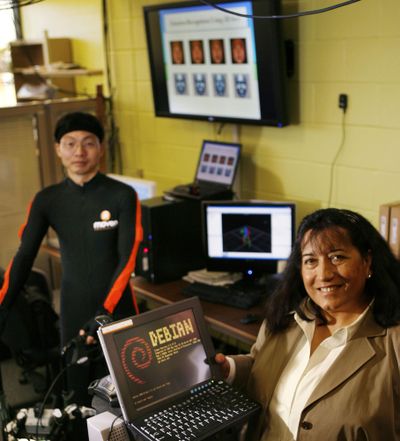Robots, sensors will ease elderly lives

DALLAS – Someday soon, older adults may not need to move into nursing homes because they’ll have a household of technological wonders to keep an eye on them when they become frail.
Like smart pets that never require feeding, robots will scoot from room to room to wake the homeowners in the morning, remind them to eat and send for help if someone falls.
Sensors embedded throughout the seniors’ homes will detect when the residents have sleepless nights or forget to take their medication. Web-based computer software will notify caregivers.
“This is the future of aging,” said Fillia Makedon, a professor of computer science and engineering at the University of Texas at Arlington. “Technology will let people grow old at home.”
With support from the National Science Foundation and others, Makedon has created the Heracleia Human-Centered Computing Laboratory at UTA, where she, other faculty members and their students are designing technology that will allow tomorrow’s seniors to remain independent longer than previous generations.
The research facility and a handful of similar labs across the country will be the springboard for what experts predict will be an exploding assistive technology industry within a decade.
The UTA lab houses a make-believe one-bedroom apartment equipped with high-tech cameras, motion sensors and robots, and surrounded by computer stations.
Professors and students measure any movement within the furnished apartment and feed the data into computers that will alert them to any measurement outside a normal range.
Once the technology is perfected, caregivers will be able to sign on to a secure Web site and check how well a senior is recovering from surgery or responding to a new prescription, Makedon said.
“The goal is to create a safer environment without unnecessarily invading someone’s privacy,” Makedon said. “Caregivers will turn on the cameras only if they suspect something is wrong.”
Many experts hope that assistive technology will help ease the strain the aging population will place on the nation’s long-term care system.
There aren’t enough trained caregivers or facilities to accommodate the expected doubling of older adults over the next 25 years, said Mary Jane Koren, an assistant vice president at the Commonwealth Fund, a private foundation that studies healthcare issues.
And Medicaid, the federal-state program that pays for most long-term care after people deplete their personal resources, won’t be able to cover boomers’ costs without some form of relief, she said.
“Assistive technology will hold down long-term care costs, lighten the burden on caregivers and let the elderly stay at home, which is where most prefer to grow old,” Koren said.
A few remote monitoring systems and medication dispensers have already made it out of the research lab and into the marketplace. But experts expect a surge of devices in five to 10 years.